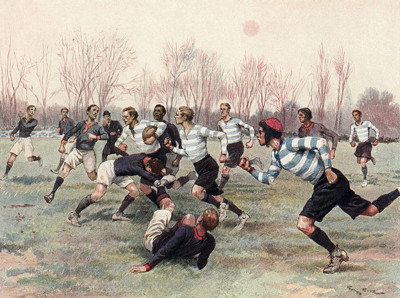Football and rugby, once closely aligned, have now become distinct sports with many differences. One of the key factors that sets them apart is the handling of the ball. In this article, we will explore the history and development of the handball rule in football, shedding light on how it has evolved over time.
Bạn đang xem: The Evolution of the Handball Rule in Football
Handball Rule in the Early Days
To understand the development of the handball rule, we must first delve into the origins of the game before the split between football and rugby. Back in the day, various schools and organizations played the game, but they couldn’t agree on a unified set of rules.
In 1848, representatives from schools such as Charterhouse, Eton, Harrow, Rugby, Shrewsbury, Westminster, and Winchester met in Cambridge to discuss the unification of football rules. One major point of contention was the use of hands in the game. Some schools allowed players to carry the ball, while others did not.
These early versions of the game were influenced by “folk football,” a medieval game with minimal rules that involved two neighboring villages competing over a ball. Though there were similarities between the schools’ rules, there were also enough differences to cause confusion when organizing matches.
The split between football and rugby truly became irreconcilable in 1871 with the formation of the Rugby Football Union. Association football, which eventually became the modern-day football, strictly forbade the use of hands during gameplay, except for the goalkeeper and throw-ins.
The Laws Develop
Handling the ball with hands was allowed until 1863, when various changes to the rules were implemented. The 1863 rules introduced the concept of a free-kick for players catching the ball. The only position exempted from this rule was the goalkeeper.
Over the years, there have been significant changes to the handball rule, particularly for goalkeepers. In 1912, a rule was introduced that restricted goalkeepers to handling the ball only within their own penalty area. In 1992, the backpass rule was implemented, preventing goalkeepers from handling the ball when it was deliberately passed back to them by a teammate using their feet.
Major Modern Day Changes to the Handball Rule
In 2013, the Select Group of Referees in the Premier League changed their approach to how handball offenses were judged. Though this change did not affect the laws of the game set by the International Football Association Board (IFAB), it influenced how referees interpreted handball incidents.
The new approach required referees to consider factors such as the proximity of the player to the kicker, the speed of the ball, and the position of the player’s arm. Instead of focusing on intentional handball, the emphasis shifted to whether the arm was in a natural position when the ball struck it.
In 2018, the IFAB considered removing the word “deliberate” from the handball rule to promote clarity. The proposed change aimed to penalize attackers for handball, regardless of intent. Starting from the 2019-2020 season, any goal scored using the hand, even accidentally, would be disallowed.
The Handball Rule
Handball offenses result in direct free-kicks or penalties, depending on their location on the field. Goalkeepers must follow the same rules as other players outside the penalty area but are allowed to handle the ball inside the area, as long as it was not intentionally passed back to them by a teammate using their feet.
Xem thêm : The Green Card: A Unique Approach to Soccer
Determining intent is a crucial aspect of judging a handball incident. Referees consider the movement of the hand in relation to the ball, the unexpectedness of the ball’s presence, the natural position of the hand, and whether the ball touches another object held or thrown from the hand, such as a boot or shinpad.
FAQs
Q: Can outfield players handle the ball?
A: No, outfield players are not allowed to handle the ball, except in cases of throw-ins.
Q: How has the handball rule changed over time?
A: The handball rule has evolved significantly, with changes in the handling of the ball and the interpretation of intent.
Q: Does accidental handball result in a penalty kick?
A: Accidental handball can result in a penalty kick if it occurs within the penalty area and meets the criteria defined by the rules.
Conclusion
The handball rule has undergone substantial changes throughout the history of football. From the early days of confusion and compromise to the modern-day emphasis on intent and clarity, the development of this rule has shaped the sport we know today. By understanding its evolution, fans and players alike can better appreciate the intricacies of the game. For more information about football and other exciting topics, visit Movin993.
Nguồn: https://movin993.com
Danh mục: Tin tức







